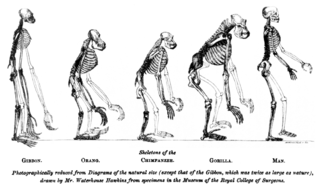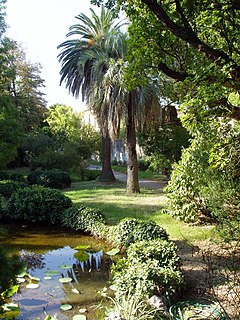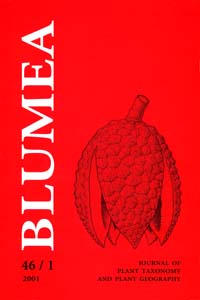Botany 2000 is the name for a scientific program, organized under the auspices of UNESCO. While a similar UNESCO program, ASOMPS, focus on promotion of collaboration and co-operation between scientists in Asia, Botany 2000 is composed of activities in Asia and Africa. Activities in Europe are confined to support of herbaria in countries in transition and reconstruction e.g. Georgia.

The United Nations Educational, Scientific and Cultural Organization is a specialized agency of the United Nations (UN) based in Paris. Its declared purpose is to contribute to peace and security by promoting international collaboration through educational, scientific, and cultural reforms in order to increase universal respect for justice, the rule of law, and human rights along with fundamental freedom proclaimed in the United Nations Charter. It is the successor of the League of Nations' International Committee on Intellectual Cooperation.

Asia is Earth's largest and most populous continent, located primarily in the Eastern and Northern Hemispheres. It shares the continental landmass of Eurasia with the continent of Europe and the continental landmass of Afro-Eurasia with both Europe and Africa. Asia covers an area of 44,579,000 square kilometres (17,212,000 sq mi), about 30% of Earth's total land area and 8.7% of the Earth's total surface area. The continent, which has long been home to the majority of the human population, was the site of many of the first civilizations. Asia is notable for not only its overall large size and population, but also dense and large settlements, as well as vast barely populated regions. Its 4.5 billion people constitute roughly 60% of the world's population.

Africa is the world's second largest and second most-populous continent, being behind Asia in both categories. At about 30.3 million km2 including adjacent islands, it covers 6% of Earth's total surface area and 20% of its land area. With 1.2 billion people as of 2016, it accounts for about 16% of the world's human population. The continent is surrounded by the Mediterranean Sea to the north, the Isthmus of Suez and the Red Sea to the northeast, the Indian Ocean to the southeast and the Atlantic Ocean to the west. The continent includes Madagascar and various archipelagos. It contains 54 fully recognised sovereign states (countries), nine territories and two de facto independent states with limited or no recognition. The majority of the continent and its countries are in the Northern Hemisphere, with a substantial portion and number of countries in the Southern Hemisphere.
The Botany 2000 program was accepted by the UNESCO General Conference in 1989.
Activities in Africa and Asia subsume activities in predecessor networks such as the:
- Botany 2000-Asia
- Botany 2000-Africa
The Botany 2000-Asia program is the new name for the former Southeast Asian Cooperative Program on Descriptive Botany (SEABOP) and of the work being carried out by the majority of the other organizations involved in the Asian Coordinating Group for Chemistry (ACGC).
Botany 2000-Asia is implemented by UNESCO's New Delhi Office and focuses on the taxonomy, and biological and cultural diversity of medicinal and ornamental plants, and their protection against environmental pollution, as well as ethnobiological classification and biological systematics and the correct documentation of useful plants through collection of voucher specimens. Within the framework of the project Botany 2000-Asia, UNESCO supports also the computerization of holdings and locations in herbaria throughout Asia.

In biology, taxonomy is the science of defining and naming groups of biological organisms on the basis of shared characteristics. Organisms are grouped together into taxa and these groups are given a taxonomic rank; groups of a given rank can be aggregated to form a super-group of higher rank, thus creating a taxonomic hierarchy. The principal ranks in modern use are domain, kingdom, phylum, class, order, family, genus, and species. The Swedish botanist Carl Linnaeus is regarded as the father of taxonomy, as he developed a system known as Linnaean taxonomy for categorizing organisms and binomial nomenclature for naming organisms.

Biodiversity refers to the variety and variability of life on Earth. Biodiversity typically measures variation at the genetic, species, and ecosystem level. Terrestrial biodiversity is usually greater near the equator, which is the result of the warm climate and high primary productivity. Biodiversity is not distributed evenly on Earth, and is richest in the tropics. These tropical forest ecosystems cover less than 10 percent of earth's surface, and contain about 90 percent of the world's species. Marine biodiversity is usually highest along coasts in the Western Pacific, where sea surface temperature is highest, and in the mid-latitudinal band in all oceans. There are latitudinal gradients in species diversity. Biodiversity generally tends to cluster in hotspots, and has been increasing through time, but will be likely to slow in the future.

Biological systematics is the study of the diversification of living forms, both past and present, and the relationships among living things through time. Relationships are visualized as evolutionary trees. Phylogenies have two components: branching order and branch length. Phylogenetic trees of species and higher taxa are used to study the evolution of traits and the distribution of organisms (biogeography). Systematics, in other words, is used to understand the evolutionary history of life on Earth.
Under the Botany 2000-Asia program some conferences were held:
- Botany 2000-Asia: Herbarium Curation Workshop (15-20 October 1990, Point Walter, Bicton, Western Australia)
- Botany 2000-Asia: Zingiberaceae Workshop (15-18 October 1991, Hat Yai, Thailand)
- Botany 2000-Asia: Rutaceae Workshop (2-7 February 1992, in conjunction with ASOMPS VII, Manila, Philippines)
- Botany 2000-Asia: International Botanical Congress (28 August-3 September 1993, Tokyo, Japan)
- Botany 2000-Asia: International Seminar and Workshop : taxonomy and phytochemistry of the Asclepiadaceae in tropical Asia (June 1994, Malacca, Malaysia) [1]
- Second Symposium on The Family Zingiberaceae (9-12 May 1995, Guangzhou, China) [2]
- Botany 2000-Asia: Workshop on the Family Apocynaceae (6-8 February 1996, Chittagong, Bangladesh)

Point Walter is a point on the Swan River, Western Australia, notable for its large sandbar that extends into the river. It is located on the southern shore of Melville Water, and forms its western end. Point Walter is located in the suburb of Bicton, approximately 12 kilometres (7 mi) south of the Perth central business district, and 7 kilometres (4 mi) north-east of Fremantle, and is on the opposite side of the river to the suburbs of Mosman Park, Peppermint Grove, and Dalkeith.
Neville Marchant, Director of the Western Australian Herbarium in Perth, has been involved in the Botany 2000-Asia programme since its inception.
The Western Australian Herbarium is the State Herbarium in Perth, Western Australia. It is part of the State government's Department of Parks and Wildlife, and has responsibility for the description and documentation of the flora of Western Australia.
The UNESCO Office, New Delhi also published the Botany 2000-Asia Newsletter four times a year. A typical issue contains news on workshops, training courses, databases, projects and forthcoming meetings as well as reports on unauthorized collection and export of medicinal plants from the region. The editor requests one to two page articles and reports of seminars and meetings of general relevance to botany and ethnobotany in Asia. Apart from producing the newsletter, the UNESCO Botany 2000-Asia program sponsors occasional workshops on the taxonomy, ethnobotany and chemistry of various plant families, as well as training courses in herbarium techniques and curation.

Botany, also called plant science(s), plant biology or phytology, is the science of plant life and a branch of biology. A botanist, plant scientist or phytologist is a scientist who specialises in this field. The term "botany" comes from the Ancient Greek word βοτάνη (botanē) meaning "pasture", "grass", or "fodder"; βοτάνη is in turn derived from βόσκειν (boskein), "to feed" or "to graze". Traditionally, botany has also included the study of fungi and algae by mycologists and phycologists respectively, with the study of these three groups of organisms remaining within the sphere of interest of the International Botanical Congress. Nowadays, botanists study approximately 410,000 species of land plants of which some 391,000 species are vascular plants, and approximately 20,000 are bryophytes.

Ethnobotany is the study of a region's plants and their practical uses through the traditional knowledge of a local culture and people. An ethnobotanist thus strives to document the local customs involving the practical uses of local flora for many aspects of life, such as plants as medicines, foods, and clothing. Richard Evans Schultes, often referred to as the "father of ethnobotany", explained the discipline in this way:
Ethnobotany simply means ... investigating plants used by societies in various parts of the world.

Phytochemistry is the study of phytochemicals, which are chemicals derived from plants. Those studying phytochemistry strive to describe the structures of the large number of secondary metabolic compounds found in plants, the functions of these compounds in human and plant biology, and the biosynthesis of these compounds. Plants synthesize phytochemicals for many reasons, including to protect themselves against insect attacks and plant diseases. Phytochemicals in food plants are often active in human biology, and in many cases have health benefits. The compounds found in plants are of many kinds, but most are in four major biochemical classes, the alkaloids, glycosides, polyphenols, and terpenes.
Botany 2000-Africa is implemented by UNESCO's Nairobi Office and deals with the conservation and use of the medicinal flora of Africa.
Some of the activities of the Botany 2000-Africa program are published in: S. Edwards and Z. Asfaw (Editors): The Status of Some Plant Resources in Parts of Tropical Africa. Botany 2000: East and Central Africa; NAPRECA Monograph Series No. 2. Published by Natural Products Research Network for Eastern and Central Africa (NAPRECA), Addis Ababa University, Addis Ababa, 1992.
The UNESCO Botany 2000 program is different from the annual meeting of the Botanical Society of America (BSA), who organised an annual scientific conference named Botany. This Botany 2000 : New Frontiers in Botany conference was held in Portland, Oregon on 6-10 August 2000.












